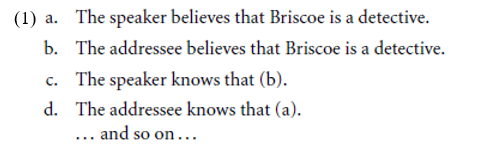
A case study of the semantics of clear - Factivity revisited
 المؤلف:
GINA TARANTO
المؤلف:
GINA TARANTO
 المصدر:
Adjectives and Adverbs: Syntax, Semantics, and Discourse
المصدر:
Adjectives and Adverbs: Syntax, Semantics, and Discourse
 الجزء والصفحة:
P321-C10
الجزء والصفحة:
P321-C10
 2025-05-04
2025-05-04
 806
806
A case study of the semantics of clear - Factivity revisited
With this analysis of the semantics of clear in place, it is possible to explain the intuitive feeling that clear is a factive predicate. In the absence of an overt experiencer, the entities doing the experiencing are by default interpreted as the speaker and addressee. The semantics of simple clarity guarantees that in the absence of an immediate and overt objection by the addressee, every world in the updated context will be a world in which the experiencer believes the truth of the proposition. The result is that, in terms of the model relevant to a particular discourse, the discourse participants believe the proposition is likely to be true in every world in the updated context. Thus, asserting It is clear that p doesn’t entail p, but it guarantees that the discourse participants are justified in behaving as if p is true. The key point to note is that asserting clarity is purely about the judgment of the discourse participants, and not about what is the case in any part of the world under discussion. That is, asserting clarity synchronizes the common ground. It forces the speaker and addressee to acknowledge that they are in a position to treat a certain proposition as if it were a fact.
In particular, (1) lists some things that at least one of the discourse participants might learn after an assertion of clarity that they might not have known before the assertion.

On this analysis, an utterance with a discourse adjective is analyzed as a move by a speaker to synchronize the common ground by promoting what she believes might be shared private beliefs to the status of mutual public beliefs in the context set of a discourse. This analysis provides an explanation of what Barker and Taranto identified as the paradox of asserting clarity (the observation that It is clear that p can be felicitously uttered in situations where it is in fact not clear that p). Specifically, asserting clarity does not require asserting perfect clarity. By recognizing the role of vagueness, the analysis shows that asserting clarity means that the proposition is clear enough to proceed as if it were true.
 الاكثر قراءة في Semantics
الاكثر قراءة في Semantics
 اخر الاخبار
اخر الاخبار
اخبار العتبة العباسية المقدسة


